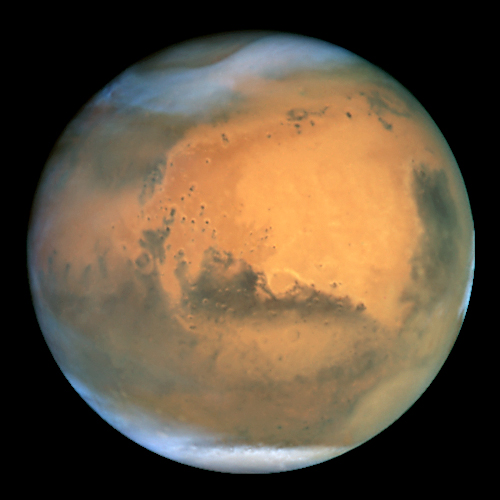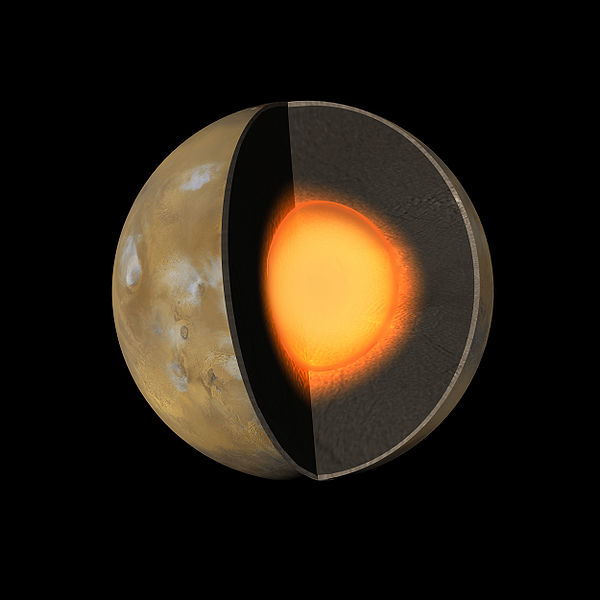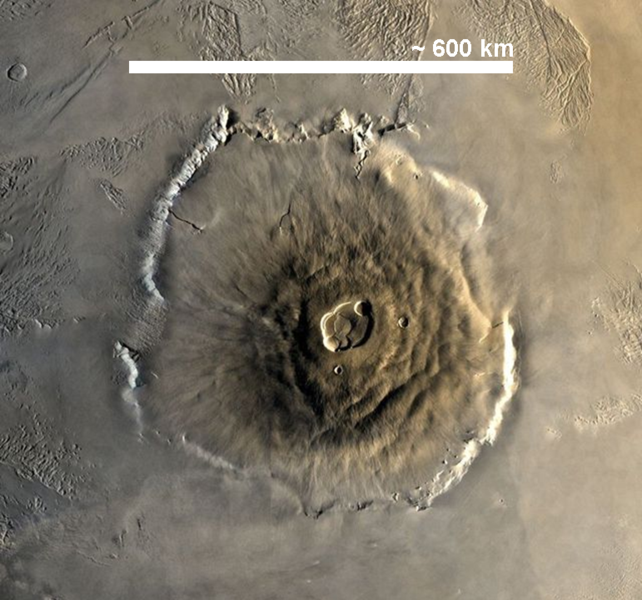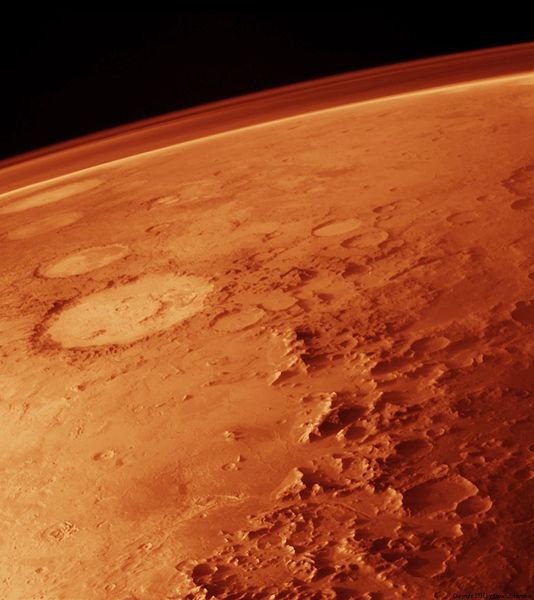solar System
HOME
Mercury VenusEarth
Mars
Galerie Extra
 |
 |
 |
Mars
Mars is the fourth planet from the Sun and the second smallest planet in the Solar System, after Mercury. Named after the Roman god of war, it is often described as the "Red Planet" because the iron oxide prevalent on its surface gives it a reddish appearance. Mars is a terrestrial planet with a thin atmosphere, having surface features reminiscent both of the impact craters of the Moon and the volcanoes, valleys, deserts, and polar ice caps of Earth. The rotational period and seasonal cycles of Mars are likewise similar to those of Earth, as is the tilt that produces the seasons. Mars is the site of Olympus Mons, the second highest known mountain within the Solar System (the tallest on a planet), and of Valles Marineris, one of the largest canyons. The smooth Borealis basin in the northern hemisphere covers 40% of the planet and may be a giant impact feature. Mars has two moons, Phobos and Deimos, which are small and irregularly shaped. These may be captured asteroids, similar to 5261 Eureka, a Mars trojan.

Until the first successful Mars flyby in 1965 by Mariner 4, many speculated about the presence of liquid water on the planet's surface. This was based on observed periodic variations in light and dark patches, particularly in the polar latitudes, which appeared to be seas and continents; long, dark striations were interpreted by some as irrigation channels for liquid water. These straight line features were later explained as optical illusions, though geological evidence gathered by unmanned missions suggests that Mars once had large-scale water coverage on its surface at some earlier stage of its life. In 2005, radar data revealed the presence of large quantities of water ice at the poles and at mid-latitudes. The Mars rover Spirit sampled chemical compounds containing water molecules in March 2007. The Phoenix lander directly sampled water ice in shallow Martian soil on July 31, 2008.
Mars is host to seven functioning spacecraft: five in orbit – the Mars Odyssey, Mars Express, Mars Reconnaissance Orbiter, MAVEN and Mars Orbiter Mission – and two on the surface – Mars Exploration Rover Opportunity and the Mars Science Laboratory Curiosity. Defunct spacecraft on the surface include MER-A Spirit and several other inert landers and rovers such as the Phoenix lander, which completed its mission in 2008. Observations by the Mars Reconnaissance Orbiter have revealed possible flowing water during the warmest months on Mars. In 2013, NASA's Curiosity rover discovered that Mars' soil contains between 1.5% and 3% water by mass (about two pints of water per cubic foot or 33 liters per cubic meter, albeit attached to other compounds and thus not freely accessible).
Mars can easily be seen from Earth with the naked eye, as can its reddish coloring. Its apparent magnitude reaches -3.0, which is surpassed only by Jupiter, Venus, the Moon, and the Sun. Optical ground-based telescopes are typically limited to resolving features about 300 km (186 miles) across when Earth and Mars are closest because of Earth's atmosphere.
Physical characteristics
Mars has approximately half the diameter of Earth. It is less dense than Earth, having about 15% of Earth's volume and 11% of the mass. Its surface area is only slightly less than the total area of Earth's dry land. Although Mars is larger and more massive than Mercury, Mercury has a higher density. This results in the two planets having a nearly identical gravitational pull at the surface—that of Mars is stronger by less than 1%. The red-orange appearance of the Martian surface is caused by iron(III) oxide, more commonly known as hematite, or rust. It can also look like butterscotch, and other common surface colors include golden, brown, tan, and greenish, depending on minerals.

Internal structure Like Earth, this planet has undergone differentiation, resulting in a dense, metallic core region overlaid by less dense materials. Current models of the planet's interior imply a core region about 1,794 ± 65 kilometres (1,115 ± 40 mi) in radius, consisting primarily of iron and nickel with about 16–17% sulfur. This iron sulfide core is partially fluid, and it has twice the concentration of the lighter elements that exist at Earth's core. The core is surrounded by a silicate mantle that formed many of the tectonic and volcanic features on the planet, but it now appears to be dormant. Besides silicon and oxygen, the most abundant elements in the Martian crust are iron, magnesium, aluminum, calcium, and potassium. The average thickness of the planet's crust is about 50 km (31 mi), with a maximum thickness of 125 km (78 mi). Earth's crust, averaging 40 km (25 mi), is only one third as thick as Mars' crust, relative to the sizes of the two planets. The InSight lander planned for 2016 will use a seismometer to better constrain the models of the interior.
Surface geology Mars is a terrestrial planet that consists of minerals containing silicon and oxygen, metals, and other elements that typically make up rock. The surface of Mars is primarily composed of tholeiitic basalt, although parts are more silica-rich than typical basalt and may be similar to andesitic rocks on Earth or silica glass. Regions of low albedo show concentrations of plagioclase feldspar, with northern low albedo regions displaying higher than normal concentrations of sheet silicates and high-silicon glass. Parts of the southern highlands include detectable amounts of high-calcium pyroxenes. Localized concentrations of hematite and olivine have also been found. Much of the surface is deeply covered by finely grained iron(III) oxide dust.
Although Mars has no evidence of a current structured global magnetic field, observations show that parts of the planet's crust have been magnetized, and that alternating polarity reversals of its dipole field have occurred in the past. This paleomagnetism of magnetically susceptible minerals has properties that are similar to the alternating bands found on the ocean floors of Earth. One theory, published in 1999 and re-examined in October 2005 (with the help of the Mars Global Surveyor), is that these bands demonstrate plate tectonics on Mars four billion years ago, before the planetary dynamo ceased to function and the planet's magnetic field faded away.
During the Solar System's formation, Mars was created as the result of a stochastic process of run-away accretion out of the protoplanetary disk that orbited the Sun. Mars has many distinctive chemical features caused by its position in the Solar System. Elements with comparatively low boiling points, such as chlorine, phosphorus, and sulphur, are much more common on Mars than Earth; these elements were probably removed from areas closer to the Sun by the young star's energetic solar wind.
After the formation of the planets, all were subjected to the so-called "Late Heavy Bombardment". About 60% of the surface of Mars shows a record of impacts from that era,[43][44] whereas much of the remaining surface is probably underlain by immense impact basins caused by those events. There is evidence of an enormous impact basin in the northern hemisphere of Mars, spanning 10,600 km by 8,500 km, or roughly four times larger than the Moon's South Pole – Aitken basin, the largest impact basin yet discovered. This theory suggests that Mars was struck by a Pluto-sized body about four billion years ago. The event, thought to be the cause of the Martian hemispheric dichotomy, created the smooth Borealis basin that covers 40% of the planet.
The geological history of Mars can be split into many periods, but the following are the three primary periods: • Noachian period (named after Noachis Terra): Formation of the oldest extant surfaces of Mars, 4.5 billion years ago to 3.5 billion years ago. Noachian age surfaces are scarred by many large impact craters. The Tharsis bulge, a volcanic upland, is thought to have formed during this period, with extensive flooding by liquid water late in the period. • Hesperian period (named after Hesperia Planum): 3.5 billion years ago to 2.9–3.3 billion years ago. The Hesperian period is marked by the formation of extensive lava plains. • Amazonian period (named after Amazonis Planitia): 2.9–3.3 billion years ago to present. Amazonian regions have few meteorite impact craters, but are otherwise quite varied. Olympus Mons formed during this period, along with lava flows elsewhere on Mars.
Some geological activity is still taking place on Mars. The Athabasca Valles is home to sheet-like lava flows up to about 200 Mya. Water flows in the grabens called the Cerberus Fossae occurred less than 20 Mya, indicating equally recent volcanic intrusions.[50] On February 19, 2008, images from the Mars Reconnaissance Orbiter showed evidence of an avalanche from a 700 m high cliff.
Soil The Phoenix lander returned data showing Martian soil to be slightly alkaline and containing elements such as magnesium, sodium, potassium and chlorine. These nutrients are found in gardens on Earth, and they are necessary for growth of plants. Experiments performed by the Lander showed that the Martian soil has a basic pH of 7.7, and contains 0.6% of the salt perchlorate.
Streaks are common across Mars and new ones appear frequently on steep slopes of craters, troughs, and valleys. The streaks are dark at first and get lighter with age. Sometimes, the streaks start in a tiny area which then spread out for hundreds of metres. They have also been seen to follow the edges of boulders and other obstacles in their path. The commonly accepted theories include that they are dark underlying layers of soil revealed after avalanches of bright dust or dust devils. Several explanations have been put forward, some of which involve water or even the growth of organisms.

Hydrology Liquid water cannot exist on the surface of Mars due to low atmospheric pressure, which is about 100 times thinner than Earth's, except at the lowest elevations for short periods. The two polar ice caps appear to be made largely of water. The volume of water ice in the south polar ice cap, if melted, would be sufficient to cover the entire planetary surface to a depth of 11 meters. A permafrost mantle stretches from the pole to latitudes of about 60°.
Large quantities of water ice are thought to be trapped within the thick cryosphere of Mars. Radar data from Mars Express and the Mars Reconnaissance Orbiter show large quantities of water ice both at the poles (July 2005) and at mid-latitudes (November 2008). The Phoenix lander directly sampled water ice in shallow Martian soil on July 31, 2008.
Landforms visible on Mars strongly suggest that liquid water has at least at times existed on the planet's surface. Huge linear swathes of scoured ground, known as outflow channels, cut across the surface in around 25 places. These are thought to record erosion which occurred during the catastrophic release of water from subsurface aquifers, though some of these structures have also been hypothesized to result from the action of glaciers or lava. One of the larger examples, Ma'adim Vallis is 700 km long and much bigger than the Grand Canyon with a width of 20 km and a depth of 2 km in some places. It is thought to have been carved by flowing water early in Mars' history. The youngest of these channels are thought to have formed as recently as only a few million years ago. Elsewhere, particularly on the oldest areas of the Martian surface, finer-scale, dendritic networks of valleys are spread across significant proportions of the landscape. Features of these valleys and their distribution strongly imply that they were carved by runoff resulting from rain or snow fall in early Mars history. Subsurface water flow and groundwater sapping may play important subsidiary roles in some networks, but precipitation was probably the root cause of the incision in almost all cases.
Along crater and canyon walls, there are also thousands of features that appear similar to terrestrial gullies. The gullies tend to be in the highlands of the southern hemisphere and to face the Equator; all are poleward of 30° latitude. A number of authors have suggested that their formation process demands the involvement of liquid water, probably from melting ice, although others have argued for formation mechanisms involving carbon dioxide frost or the movement of dry dust. No partially degraded gullies have formed by weathering and no superimposed impact craters have been observed, indicating that these are young features, possibly even active today.

Other geological features, such as deltas and alluvial fans preserved in craters, also argue strongly for warmer, wetter conditions at some interval or intervals in earlier Mars history.Such conditions necessarily require the widespread presence of crater lakes across a large proportion of the surface, for which there is also independent mineralogical, sedimentological and geomorphological evidence. Some authors have even gone so far as to argue that at times in the Martian past, much of the low northern plains of the planet were covered with a true ocean hundreds of meters deep, though this remains controversial.)
Further evidence that liquid water once existed on the surface of Mars comes from the detection of specific minerals such as hematite and goethite, both of which sometimes form in the presence of water. Some of the evidence believed to indicate ancient water basins and flows has been negated by higher resolution studies by the Mars Reconnaissance Orbiter.In 2004, Opportunity detected the mineral jarosite. This forms only in the presence of acidic water, which demonstrates that water once existed on Mars. More recent evidence for liquid water comes from the finding of the mineral gypsum on the surface by NASA's Mars rover Opportunity in December 2011. Additionally, the study leader Francis McCubbin, a planetary scientist at the University of New Mexico in Albuquerque looking at hydroxals in crystalline minerals from Mars, states that the amount of water in the upper mantle of Mars is equal to or greater than that of Earth at 50–300 parts per million of water, which is enough to cover the entire planet to a depth of 200–1,000 m (660–3,280 ft).
On March 18, 2013, NASA reported evidence from instruments on the Curiosity rover of mineral hydration, likely hydrated calcium sulfate, in several rock samples including the broken fragments of "Tintina" rock and "Sutton Inlier" rock as well as in veins and nodules in other rocks like "Knorr" rock and "Wernicke" rock. Analysis using the rover's DAN instrument provided evidence of subsurface water, amounting to as much as 4% water content, down to a depth of 60 cm, in the rover's traverse from the Bradbury Landing site to the Yellowknife Bay area in the Glenelg terrain.
| up | Links: Google.en, Wikipedia.org | |